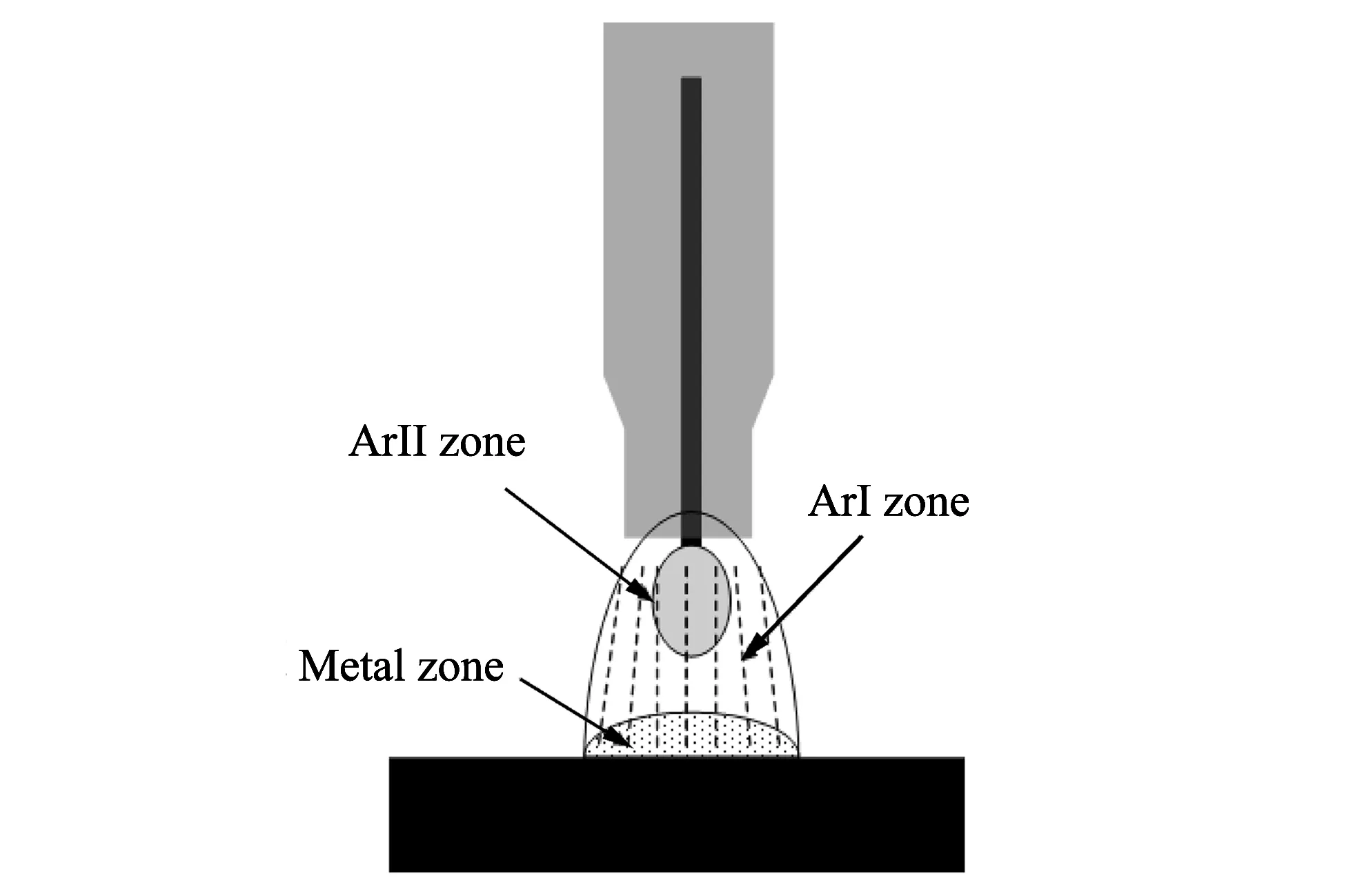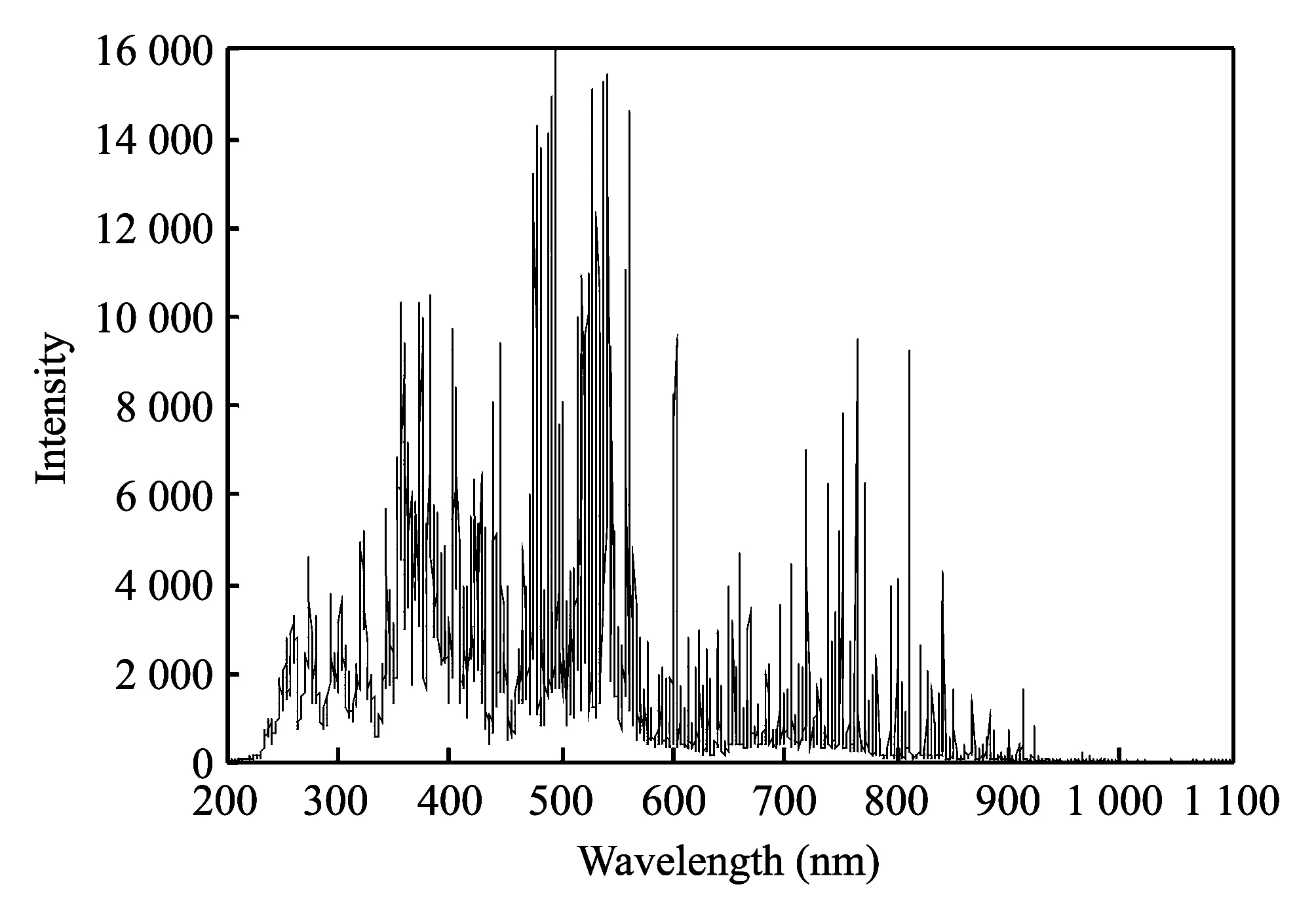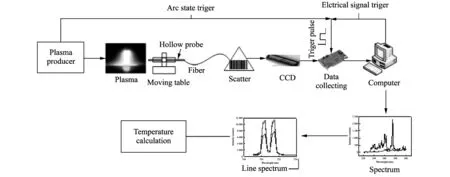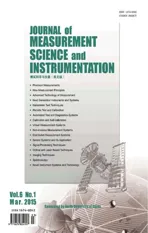A spectrum measurement system for arc plasma with time and spatial indentification
2015-07-06LIZhiyongFENGLiYANGJuntaoFANLiyu
LI Zhi-yong, FENG Li, YANG Jun-tao, FAN Li-yu
(College of Material Science and Engineering, North University of China, Taiyuan 030051, China)
A spectrum measurement system for arc plasma with time and spatial indentification
LI Zhi-yong, FENG Li, YANG Jun-tao, FAN Li-yu
(CollegeofMaterialScienceandEngineering,NorthUniversityofChina,Taiyuan030051,China)
Spectrum analysis of the plasma has over the years been growing both in methods and instrument, which makes it become a widely used non-contact detection method, without disturbing the arc plasma itself. With noticeable developments in the industry application of the method, a need for careful analysis of the plasma with both time and space identification is desirable. Therefore, a spectral measurement system is developed in this paper for diagnosing arc plasma with time and space identification. With a new hollow probe scanning method, the instrument can be used to provide information like energy distribution of plasma, temperature within the arc plasma, which are of great significance with the requirement of space identification. Furthermore, the system can also be used to capture the instant state of the arc plasma with the synchronic triggering system, which uses high speed photo and electrical signal as the time criterion. The industry applications prove that the system works well for online detection of the arc plasma.
spectrum; plasma; time identification; space identification
0 Introduction
The arc plasma is widely used in industry such as the source of spraying, welding, cutting and heating. The properties of the plasma are directly related to the quality of the processed material. Therefore, a lot of research work, such as simulation, parameter experiment and physics analysis, had been done on the arc plasma from different points of view[1-2]. With the development of different processes applying arc plasma, exact and efficient measurement of the arc plasma becomes a necessary, among which, spectral measurement of the plasma is of significance for the study of the arc plasma[3-4]. Spectral measurement of the arc plasma has the advantage of no disturbance of the arc. We can collect the radiation from the whole plasma and calculate the physical characteristics of the arc by spectrum analysis. Therefore, spectral measurement of the arc plasma is gaining its place in arc plasma study[5].
However, the most widely used spectrometer in industry, such as optical fiber spectrometer, can only provide spectrum of the arc radiation entering the fiber of the instrument. The method cannot distinguish the radiation from different points of the plasma. Furthermore, the arc plasma always fluctuates during the welding process[6]. These bring a lot of difficulties in the exact diagnosis of the arc plasma.
Firstly, it is know that the arc plasma is a radiation body with extension in three directions. Different points of the arc plasma emit radiation with different intensity in certified frequency, which cannot be regarded as a unify body[7]. As is shown in Fig.1, a welding arc with shielding gas Ar emits radiation from different points of the plasma.

Fig.1 A schematic of a metal arc welding plasma
The unbalance distribution of Ar, Fe and the temperature is the dominate factor deciding the radiation spectrum. Therefore, the researchers need to get the spatial distribution of the arc plasma for further and thoroughly study of the plasma[8]. The traditional measurement methods cannot provide the radiation information from different points of the plasma. The most obviously original method is to get the spectrum
with a multi-channel spectrometer, which has fibers arranged according to the spatial requirement. However, this may bring two main problems: 1) the price of the system is very high; 2) the spatial resolution cannot be good enough to get the required information. Above all, the spatial information of the arc plasma is very important because it can provide information related to the arc distribution, which can be used for spatial temperature measurement, energy distribution analysis and so on.
Secondly, when the arc plasma changes very fast due to droplet transfer and the flash plasma breaks between voltage electrodes, the time identification is of great importance. High speed photo can provide a lot of information of the arc and has been used by many researchers[9]. As is shown in Fig.2, the arc plasma vibrates very fast due to instability of electric parameters. In this condition, we need to capture the radiation in a rapid shot and also need to know the state of the arc plasma. All of the above factors bring difficulties in measurement of the arc plasma.

Fig.2 Arc plasma vibration (high speed photo)
Therefore, a new spectral measurement system is developed in this paper with the application of synchronic control method. The system can measure the spectrum of the arc plasma with spatial identification and time identification.
1 Theory base
Basically, the arc plasma is one of the most elementary physical phenomena caused by gas discharge emitting strong radiation. Radiation of the arc plasma can provide abundant information related to the source itself. With a spectrometer, it can be found that the radiation emits spectrum from infrared to ultraviolet. The radiation can also be divided into several classifications according to the mechanism of radiation.
The line spectrum is mainly caused by excitation radiation, which is formed when electrons of atoms or ions transit from higher energy levels to lower energy levels. Because every energy level is constant, the emitted spectrum have a certain frequency which produces radiation with the form of line spectrum. Each type of atom produces its characteristic line spectra.
The continuous spectrum is produced by both bremsstrahlung and quasi-blackbody radiation. Bremsstrahlung radiation is resulted from acceleration or deceleration of electron in the Coulomb field. Melted metal droplets in the arc plasma are treated as quasi-blackbody. The spectrum is continuous and its frequency distribution follows the famous Planck law. Besides that, there is recombination radiation which has a form of step-wise continuous, resulted from free electrons and ions recombining during collision[10].
As shown in Fig.3, the spectrum of a gas metal arc is collected. The frequency band lies from 200 nm to 1 100 nm. From Fig.3 it is noted that the spectrum of the arc is composed of both line spectra and continuous spectra. The spectrum in the above frequency can be used to diagnose the physics state of the arc plasma.

Fig.3 Spectrum of Ar shielding gas metal arc
For analysis of arc radiation, the information relat-
ed to frequency, space and time is required in different situations. However, it is unacceptable to acquire all of the information in a same collection. Therefore, we must decide the dominant requirement. For example, as shown in Fig.2, if the plasma is a dynamic one and we need to know the instant sate of the plasma, the time identification is of great significant. On the other hand, if you want to get the radiation distribution of the arc plasma, the spatial identification is necessary. In all of the conditions, the spectrum within the frequency band from 200-1 100 nm must be acquired with a spectrometer.
2 Measurement system
Based on the analysis, it is known that a time identification method and a spatial identification method must be considered together for developing the measurement system. In order to make it clear for further description, the schematic of the measurement system is given in Fig.4. As shown in Fig.4, a plasma is produced for detection by arc ignition. A hollow probe method is developed for spatial identification. A pulse trigger method is developed for time identification. A digital spectrometer is applied for spectrum acquiring, which is controlled by the data collecting card. Optical fiber is used to transfer the radiation to the spectrometer. The spectrum is then collected and transferred to the computer for further analysis, such as temperature measurement. The detail of the measurement system is then introduced separately for time identification and spatial identification.

Fig.4 Schematic of measurement system
2.1 Time identification
As shown in Fig.4, the collecting system use a data collecting card to trigger the spectrometer for collecting the spectrum at a defined time. When the spectrometer is triggered, the radiation is scattered and then sensed by a charge coupled device (CCD) for spectrum collecting. A quick optical key is used to acquire the spectrum in a preset time limit, which is 2 ms. However, it is not a simple one if the arc fluctuates randomly and the state of the plasma cannot be defined. Even though the spectrometer can be triggered to collect the spectrum at the selected exact time, it is not known the state of the plasma at the exact time because the arc plasma is changing very fast. That means the time scheduled collection will be no mean if we do not know the state of the arc.
In this system, we can collect the spectrum with the “real time identification”, which means knowing the state of the plasma at the exact collecting time. In order to certify state of the plasma, high speed photo or electrical signal is used as a time standard. High speed photo and electrical signal have been widely used for studying the physics state of the arc plasma. As shown in Fig.5, a schematic is provided to illustrate the short-circuit droplet transfer and the state of the arc plasma. The corresponding electrical signal can be used to certify the state of the arc. Therefore, if we simultaneously collect the electrical signal or high speed photo as a time standard, we can thus collect the spectrum with a “real time identification”.
As shown in Fig.6, the developed system produces 5 V electrical pulses for triggering the data collection. The pulses have an exact time schedule which is got by a clock counting within the system. Thus, the pulses are sent simultaneously for the electrical signal collecting, high speed photo capturing and spectrum collecting. The difference is that only one shot pulse is required for triggering the electrical signal collecting and high speed photo capturing, while continuous pulses with exact time schedule are required for the spectrum collecting. When one shot pulse triggers the high speed camera and the electrical signal, they will get the information of the arc plasma continuously. The high speed camera can catch picture 1 000 to 5 000 frames every second with nearly the same time period. The electrical signal can collect current and voltage signal several ten thousand points every second. However, the spectrometer cannot catch the spectrum with speed as high as the high speed photo and electrical signal. Besides, the period time between two spectrum collecting cannot be exactly decided. Therefore, it must work on the multi-trigger mode, which means the pulse with exact time schedule is sent to trigger the spectrometer. The spectrometer will collect the radiation within the exact 2 ms after every triggering, which is preset in the spectrometer. Therefore, with the system, we can acquire the spectrum with “real time identification”.

Fig.6 Pulse schedule of trigger
2.2 Spatial identification
The spatial identification of the arc plasma is also very important because it helps to acquire the characteristic radiation from different points of the plasma body. For example, with the development of modern welding, cutting and spraying, arc plasmas with high energy intensity are required in different conditions. However, as is discussed in 3.1, when we used a fiber digital spectrometer to collect the radiation, the radiation from different points of the plasma enters the spectrometer, forming the composed spectrum. The traditional method cannot provide any information related to spatial identificaton. Some researchers use slit to select the radiation entering the spectrometer, which can only provide information in height direction.
In our research work, a newly developed radiation selecting method is applied. As shown in Fig.7, a hollow probe is used to let the radiation within 1.0 mm diameter to be collected by the spectrometer. The hollow probe is 400 mm long with 1.0 mm inner diameter, which makes radiation only in the selected point can pass through the probe. Radiation from other points will be prevented from passing the probe because the radiation will be absorbed after times of reflections. Compared with traditional slit image method, the hollow probe method has the advantage of exact spatial location withXaxis andYaxis identification. The collected radiation is not affected by lens absorbance. Furthermore, the radiation heat is cut down dramatically. This is important for resolving the troubles of radiation saturation and spectrometer protection.
The probe is coaxial arrangement with the fiber, which is mounted on a three direction moving system. The movement inXdirection is speeded with a motor. The movement inYandZis adjusted with the resolution as 0.01 mm. The probe can be adjusted to a selected height decided byYmovement. Then, the probe can move automatically with a selected speed, which makes the probe passing the arc plasma. When the probe passes the plasma, the spectrometer works in the continuous collecting mode, forming the spatial distribution of the spectrum. By adjustingY, we can get the spatial distribution of the whole arc plasma. The only disadvantage of the system is that the plasma must be a stable arc.

Fig.7 Hollow probe method for spatial collection
3 Industry applications
The developed system is used for industry measurement of the plasma. For time identification, the system is used for a hybrid laser-arc plasma. The hybrid arc plasma vibrates with the welding current pulse during the process. The researchers must know the exact state of the plasma. As shown in Fig.8, the collected information related to arc plasma in base state and pulse state is simultaneously given. As shown in Fig.8(b), the arc radiation is very weak and the radiation intensity is basically unchanged in the base sate. In the pulse state (Fig.8(a)), with the sharp increase of current, the volume of plasma expands and radiation intensity increases in a short instant.
For spatial identification, the system is used for diagnosing of a tungsten inert gas arc. During the process, the arc is stable because the tungsten electrode will not melt during the welding process. The stable arc makes it possible to detect the spatial distribution of plasma with the instrument developed in this paper. Fig.9 shows the collected spatial distribution of tungsten inert gas (TIG) radiation in selected frequency (Fig.9(a)) and the calculated temperature at the center of the arc plasma (Fig.9(b)).

Fig.8 Time identificaton collection of laser-arc hybrid plasma

Fig.9 Spatial spectrum distribution of TIG plasma and calculated temperature
4 Conclusion
With the developed system, the spectrum of plasma ranging from 200-1 100 nm can be acquired, while providing information related to time and space. The system provides a viable method to diagnose the arc plasma with fast vibration by a multi informational synchronic triggering method. The instant state of the plasma can be decided by the electrical signal or high speed photo. The method helps to give a real time identification rather than just providing a time schedule. Furthermore, with a scanning hollow probe, the spatial radiation of the arc plasma can be collected, which can be used to calculate the temperature and density of atoms at different points of the plasma.
[1] Bebiano D, Alfaro S C A. A weld defects detection system based on a spectrometer. Sensors, 2009, 9(7): 2851-2861.
[2] Garcia-Allende P B, Mirapeix J, Conde O M, et al. Spectral processing technique based on feature selection and artificial neural networks for arc-welding quality monitoring, Nondestructive Testing and Evaluation International, 2009, 42 (1): 56-63.
[3] LI Peng-jun, ZHANG Yu-ming. Robust sensing of arc length, IEEE Transactions on Instrumentation and Measurement, 2001, 50(3): 697-704.
[4] Ogawa Y. High speed imaging technique Part 1-high speed imaging of phenomena, Science & Technology of Welding & Joining, 2011, 16(1): 33-43.
[5] LI Zhi-yong, WANG Bao, DING Jin-bin. Detection of GTA welding quality and disturbance factors with spectral signal of arc light, Journal of Material Processing Technology, 2009, 209(10): 4867-4873.
[6] FENG Jie-cai, LI Li-qun, LEI Zheng-long, et al. Effects of welding velocity on the impact behavior of droplets in gas metal arc welding. Journal of Materials Processing Technology, 2012, 212(11): 2163-2172.
[7] Cho D W, Lee S H, Na S J. Characterization of welding arc and weld pool formation in vacuum gas hollow tungsten arc welding. Journal of Materials Processing Technology, 2013, 213(2): 143-152.
[8] WANG Xin-xin, FAN Ding, HUANG Jian-kang, et al. Numerical simulation of arc plasma and weld pool in double electrodes tungsten inert gas welding. International Journal of Heat and Mass Transfer, 2015, 85: 924-934.
[9] Ogawa Y. High speed imaging technique Part 1-high speed imaging of arc welding phenomena. Science & Technology of Welding & Joining, 2011, 16(1): 33-43.
[10] LI Zhi-yong, WANG Bao, DING Jian-bin. Detection of GTA welding quality and disturbance factors with spectral signal of arc light. Journal of Material Processing Technology, 2009, 209(10): 4867-4873.
一种具有时间和空间分辨的等离子体光谱测量系统
李志勇, 冯 立, 杨军涛, 范力予
(中北大学 材料科学与工程学院, 太原 山西 030051)
等离子体光谱分析技术和设备作为一种非介入式测量方法, 不干扰等离子体本身, 在近年来得到广泛应用。 随着其工业应用的增加, 能够实现空间和时间分辨的光谱检测方法和装置越来越重要。 因此, 本文提出了一种能实现空间和时间分辨的等离子体光谱检测方法。 采用中空探针法实现空间分辨光谱诊断, 可以获得等离子体能量分布、等离子体内温度测量等功能。 同时, 本方法采用多信息同步采集触发方法, 将等离子体电信号和高速摄像信息作为时间标尺, 实现对等离子体瞬时状态的时间分辨分析。 工业应用表明本文的方法可以很好地应用于等离子体的在线诊断。
光谱; 等离子体; 时间分辨; 空间分辨
LI Zhi-yong, FENG Li, YANG Jun-tao, et al. A spectrum measurement system for arc plasma with time and spatial indentification. Journal of Measurement Science and Instrumentation, 2015, 6(1): 75-82.
10.3969/j.issn.1674-8042.2015.01.014
s: Research Project Supported by Shanxi Scholarship Council of China (No.2012-69); Selected Research Project by Department of Human Resources and Social Security of Shanxi
LI Zhi-yong (lizhiyong@nuc.edu.cn)
1674-8042(2015)01-0075-08 doi: 10.3969/j.issn.1674-8042.2015.01.014
Received date: 2014-10-26
CLD number: O433.1 Document code: A
猜你喜欢
杂志排行
Journal of Measurement Science and Instrumentation的其它文章
- Design of multi-channel data acquisition system based on LabVIEW and NI PXI-5105
- A method based on vector type for sparse storage and quick access to projection matrix
- Usage of global navigation systems for detection of dangerous meteorological phenomena
- Approach for epileptic EEG detection based on gradient boosting
- Test system for miniature pulse-powered photoelectric invert switch based on CPLD
- Underground vibration signal detection and processing system based on LabWindows/CVI
